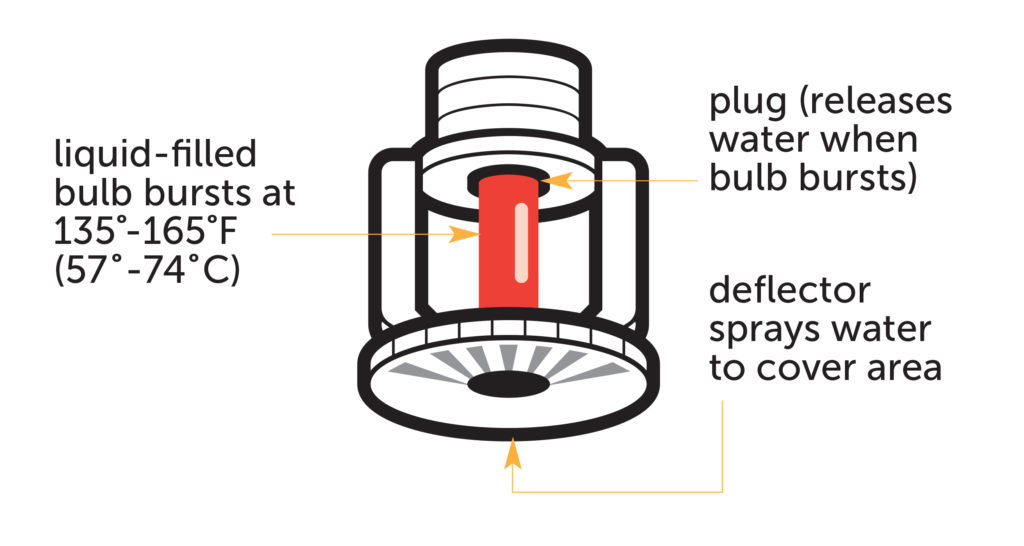Insuring a Sprinklered Home

Insuring a Home with Home Fire Sprinklers
A home that is protected with fire sprinklers provides valuable peace of mind for your customers, and for you. The benefits of home fire sprinklers are life safety, property protection, and increased home values.
Today much of the home fire problem is due to the changing dynamic of these blazes. Modern home construction methods, synthetic furnishings and technology (including the increasing presence of lithium-ion batteries), result in very fast, spreading fires with deadly smoke. Residents can have as few as two minutes to escape these fires.
Home fire sprinklers are the only technology that can stop a fire from spreading.
Watch this home fire timeline >
How Home Fire Sprinklers Work
Many people do not know how fire sprinklers work. They do not all go off at once. It takes high heat from a fire to activate a fire sprinkler. Smoke cannot cause a sprinkler to activate. Each sprinkler has a heat-sensitive element or bulb. When temperatures reach 135°-165°F, the bulb will break releasing the water. The sprinkler closest to the fire activates preventing toxic smoke and fire from spreading, allowing residents to escape. Water will flow controlling the fire until the fire department arrives, often extinguishing it.

Watch how a sprinkler activates >
Fire Sprinklers Reduce Fire and Water Damage
When sprinklers are present, fire is kept to the room of origin. In a typical house fire, only one, sometimes two sprinklers will activate. Each sprinkler discharges 13-18 gallons of water per minute. In an unsprinklered home fire, the toxic smoke spreads widely and more area is exposed to heat, smoke and fire. More water is needed to fight the fire, firefighter hoses discharge 250 gallons of water per minute. This greatly increases water and fire damage to the structure and contents. After a fire in a home protected with fire sprinklers, residents can often move back into the home a few days after the fire.


Watch a living room fire with and without fire sprinklers >
Maintenance is Easy
- Fire sprinklers require almost no maintenance and only work when you need them.
- Do a simple flow test about twice a year or have your sprinkler contractor do it for you.
- Occasionally do a visual inspection of the controls and sprinklers.
- Use a padlock to keep the water valve in the ON position.
- Teach your children fire sprinklers are not toys and should not be played with.
- NEVER hang anything on the sprinklers, even temporarily.
- Do not paint the sprinklers. And if you hire painters, make sure they know not to paint them.
- Don’t block the sprinklers with furniture or fabrics. If the spray is blocked the sprinkler cannot put out a fire.
- Most important, DON’T WORRY. Sprinklers are not complicated.
This short video shows how easy it is to live with home fire sprinklers: Watch now >
Two Types of Fire Sprinkler Systems
Fire sprinklers are connected to a piping network that contains water. Most home fire sprinklers use strong plastic piping and most are connected to the municipal water supply. Just like the home’s plumbing, the piping is hidden behind the walls and ceilings. In unfinished basements, the piping may be visible to view. In finished rooms, home fire sprinklers are installed on the wall or ceiling and may be concealed behind a decorative plate.
In situations where water pressure is a problem, a tank and pump may be necessary to provide water distribution to the sprinklers.
Here are the two types of fire sprinkler systems >
Fire sprinklers are good for the environment: they use less water if there’s a fire, preserve property and contents, and result in less pollutants released in the air and groundwater.
Resources for your customers
Here is a link to free resources you can share with your customers: https://homefiresprinkler.org/free-fire-sprinkler-education-materials/
Watch a virtual reality living room fire with and without fire sprinklers: https://www.youtube.com/watch?v=W_S4hmem8Co
Tools for people who live in homes protected with fire sprinklers: https://homefiresprinkler.org/living-with-fire-sprinklers-education-2/